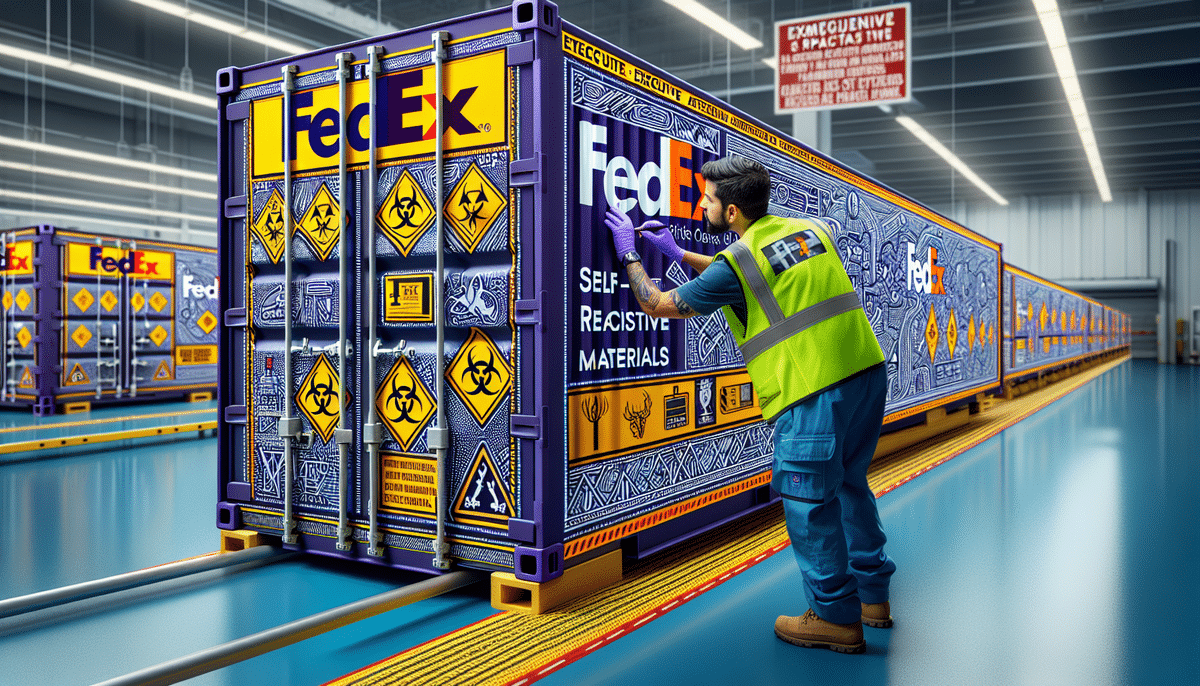FedEx Releases Guidelines for Shipping Self-Reactive Materials
In [2023](https://www.shipscience.com/fedex-guidelines-2023), FedEx released its updated guidelines for the safe shipping of self-reactive materials. These guidelines address the inherent risks associated with transporting these substances and emphasize the importance of safe handling practices. This article delves into the key aspects of shipping self-reactive materials, the potential risks involved, necessary safety precautions, and FedEx’s strategies to ensure secure transportation.
What are Self-Reactive Materials and Why are They Important in Shipping?
Self-reactive materials are substances that can undergo exothermic decomposition or polymerization, releasing significant amounts of energy. These materials are prevalent in industries such as pharmaceuticals, chemicals, and plastics. Due to their high reactivity, they are classified as hazardous, necessitating stringent shipping protocols to ensure safety.
According to the Occupational Safety and Health Administration (OSHA), improper handling of self-reactive materials can lead to severe consequences, including chemical burns, fires, and environmental damage. Therefore, adhering to regulations regarding labeling, packaging, and handling is crucial.
Proper training for employees involved in the shipping process is also essential. This training should cover the correct handling techniques, emergency response procedures, and the use of personal protective equipment (PPE). Failure to comply with these regulations can result in legal penalties, increased insurance costs, and reputational damage.
Understanding the Risks and Safety Precautions Associated with Shipping Self-Reactive Materials
Shipping self-reactive materials presents several hazards, including the risk of fire, explosions, and the release of toxic gases. These risks are heightened by the materials' ability to react with common substances like water and air, potentially leading to uncontrolled reactions during transit.
To mitigate these risks, the following safety precautions are recommended:
- Proper Packaging: Use packaging materials that can withstand shocks, vibrations, and temperature fluctuations.
- Accurate Labeling: Ensure all packages are clearly labeled with hazard symbols and handling instructions.
- Controlled Environment: Transport materials in conditions that prevent exposure to incompatible substances.
Implementing these precautions not only ensures compliance with regulations but also safeguards the well-being of individuals handling these materials and protects the environment from potential contamination.
FedEx’s Role in Ensuring Safe Transportation of Self-Reactive Materials
FedEx plays a pivotal role in the secure transportation of hazardous materials, including self-reactive substances. By collaborating with regulatory bodies such as the International Air Transport Association (IATA), International Maritime Organization (IMO), and the U.S. Department of Transportation (DOT), FedEx ensures that its shipping practices comply with international standards.
FedEx provides comprehensive training programs for its employees, focusing on the proper handling and transportation of hazardous materials. Advanced tracking and monitoring technologies are employed to oversee shipments in real-time, ensuring they remain within safe parameters throughout their journey.
Moreover, FedEx has established dedicated teams specializing in hazardous materials transportation, offering customers expert guidance and support to navigate complex shipping requirements.
The Do's and Don'ts of Packaging Self-Reactive Materials for Shipping
Effective packaging is critical for the safe transportation of self-reactive materials. Adhering to FedEx’s guidelines can significantly reduce the risk of accidents during transit.
Do's:
- Use inner packaging that is compatible with the material to prevent adverse reactions.
- Ensure all packages are sealed properly to avoid leaks or spills.
- Utilize packaging that can absorb shocks and vibrations.
Don'ts:
- Do not use damaged or compromised packaging materials.
- Avoid using inappropriate packaging that cannot withstand transportation stresses.
- Do not ignore labeling and documentation requirements set by regulatory bodies.
Following these guidelines not only ensures compliance with regulations but also enhances the safety and integrity of the shipped materials.
Compliance with Regulatory Standards: How FedEx's Guidelines Align with International Regulations
FedEx’s shipping guidelines for self-reactive materials are meticulously aligned with international regulations, ensuring compliance and safety across all borders. These guidelines encompass various aspects, including packaging standards, labeling protocols, documentation requirements, and personnel training programs.
In addition to self-reactive materials, FedEx’s protocols extend to other hazardous substances such as flammable liquids, gases, and solids. This comprehensive approach ensures that all hazardous materials are managed safely and in accordance with global standards.
FedEx’s dedicated team of hazardous materials experts provides customers with personalized support, assisting them in navigating complex regulatory landscapes and ensuring that all shipments meet the necessary compliance requirements.
Common Challenges in Shipping Self-Reactive Materials and How to Overcome Them
Shipping self-reactive materials involves navigating several challenges, including:
- Packaging Selection: Choosing the right packaging materials that can safely contain reactive substances.
- Regulatory Compliance: Adhering to varying regulations across different countries and regions.
- Personnel Training: Ensuring that employees are adequately trained to handle and respond to emergencies involving hazardous materials.
FedEx addresses these challenges by providing detailed guidelines and expert support. Their team assists customers in selecting appropriate packaging, understanding and complying with international regulations, and offering comprehensive training programs to ensure safe handling practices.
The Impact of COVID-19 on Shipping Self-Reactive Materials: FedEx's Response
The COVID-19 pandemic introduced significant disruptions to the transportation of hazardous materials, including self-reactive substances. Challenges such as supply chain interruptions, evolving regulations, and the need to maintain personnel safety became prominent.
In response, FedEx implemented enhanced safety measures, including the provision of personal protective equipment (PPE) for all employees involved in handling hazardous materials. Additionally, they increased the frequency of cleaning and disinfection protocols within their facilities and transportation vehicles to minimize the risk of virus transmission.
FedEx also adapted its guidelines to accommodate new regulatory requirements and ensure uninterrupted, safe transportation services during the pandemic.
Best Practices for Handling and Labeling Self-Reactive Materials During Transportation
Proper handling and labeling are paramount in the transportation of self-reactive materials to prevent accidents and ensure safety. FedEx’s guidelines emphasize the following best practices:
- Use of PPE: Ensure all personnel wear appropriate PPE, including gloves, masks, and protective clothing.
- Accurate Labeling: Clearly label packages with relevant hazard symbols and handling instructions to inform handlers of the risks.
- Secure Packaging: Utilize robust packaging solutions that can withstand transportation stresses and prevent leaks or spills.
Adhering to these best practices minimizes the risk of accidents and ensures that self-reactive materials are transported safely and efficiently.
What to do in Case of Accidents or Emergencies Involving Self-Reactive Materials During Shipping
Despite rigorous safety measures, accidents involving self-reactive materials can occur. FedEx’s guidelines provide a comprehensive protocol for responding to such incidents:
- Immediate Containment: Safely contain spills or leaks to prevent further reactions or environmental contamination.
- Evacuation Procedures: Evacuate the affected area to ensure the safety of personnel and bystanders.
- Emergency Contact: Notify emergency services and FedEx’s hazardous materials response team promptly.
- Incident Reporting: Document and report the incident in accordance with regulatory requirements.
Having a well-defined emergency response plan is essential for mitigating the impact of accidents and ensuring a swift and effective response.
How FedEx Continues to Innovate its Approach to Safe Transportation of Hazardous Materials
FedEx remains at the forefront of safe transportation practices by continuously innovating and integrating new technologies and safety measures. Key innovations include:
- Advanced Tracking Systems: Implementing real-time tracking to monitor shipments and respond proactively to potential issues.
- Drone Delivery: Exploring the use of drones for transporting hazardous materials in remote or hard-to-reach areas.
- Enhanced Training Programs: Offering ongoing training to employees to keep them updated on the latest safety protocols and technologies.
These innovations enable FedEx to enhance the safety, efficiency, and reliability of hazardous materials transportation, ensuring that they meet the highest standards of safety and compliance.
The Future of Shipping Hazardous Materials: Trends and Developments in Regulation and Technology
The landscape of hazardous materials transportation is continually evolving, influenced by advancements in technology and changes in regulatory frameworks. Emerging trends include:
- Automation and Robotics: Utilizing automated systems to handle and transport hazardous materials, reducing the risk of human error.
- Green Technologies: Developing eco-friendly packaging and transportation solutions to minimize environmental impact.
- Enhanced Regulatory Standards: Adapting to stricter regulations aimed at improving safety and reducing hazards associated with material transportation.
FedEx is committed to staying ahead of these trends by investing in research and development, collaborating with industry experts, and continuously updating its guidelines and technologies to ensure the safe and efficient transportation of hazardous materials.
In conclusion, FedEx’s comprehensive guidelines for shipping self-reactive materials provide a robust framework for ensuring safety and compliance. By adhering to these guidelines and embracing ongoing innovations, shippers can confidently transport self-reactive materials while minimizing risks to people and the environment.
One of the latest advancements in this field is the use of drones for transporting small quantities of hazardous materials, such as medical supplies and blood samples. This technology promises to reduce transportation time and costs while enhancing safety by minimizing human involvement. However, regulatory frameworks for drone-based transportation of hazardous materials are still under development, and widespread adoption will depend on the establishment of clear guidelines and standards.




















